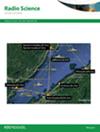The improvement and implementation of theory of Maxwellian circuit
IF 1.5
4区 地球科学
Q3 ASTRONOMY & ASTROPHYSICS
引用次数: 0
Abstract
The classical transmission line (TL) equations are constrained by the quasi-TEM (Transverse Electromagnetic) approximation. The Theory of Maxwellian Circuit (TMC) establishes a generalized TL equation. It employs full-wave analysis results to fit the distributed parameters of the TL equation, thereby determining a generalized TL equation form that is not limited to the quasi-TEM approximation. TMC can be regarded as a data-driven modeling approach. Furthermore, the TL equation formulated by TMC can serve as a reference for other generalized TL equations in terms of both equation form and parameters, including coefficient terms and inhomogeneous terms. This paper analyzes the distributed parameters and source terms in the differential equations of TMC and improves the form of the source terms, which implies corresponding changes in the values of the distributed parameter terms. Numerical simulations reveal that the improved TMC model offers improved accuracy in predicting current distribution along TLs. Furthermore, several technical details related to the numerical implementation of TMC are presented, including avoiding dealing directly with non-smooth positions in TLs, using a set of boundary conditions with weak ill-conditioning, and choosing the range of [λ/40, λ/20] as the length of segments based on computational accuracy and efficiency. These considerations represent novel contributions not previously mentioned. These studies will aid in applying machine learning to transmission line modeling and analysis and advance the development of generalized TL equations and theory.麦克斯韦电路理论的改进与实现
经典传输线(TL)方程受准tem(横向电磁)近似约束。麦克斯韦电路理论(TMC)建立了一个广义TL方程。利用全波分析结果对TL方程的分布参数进行拟合,从而确定了不局限于准tem近似的广义TL方程形式。TMC可以看作是一种数据驱动的建模方法。此外,TMC所建立的TL方程在方程形式和参数方面,包括系数项和非齐次项,都可以作为其他广义TL方程的参考。本文分析了TMC微分方程中的分布参数和源项,改进了源项的形式,使得分布参数项的值发生了相应的变化。数值模拟结果表明,改进后的TMC模型在预测沿tl的电流分布方面具有更高的精度。此外,本文还介绍了TMC数值实现的一些技术细节,包括避免直接处理tl中的非光滑位置,使用一组弱病态条件的边界条件,以及基于计算精度和效率选择[λ/40, λ/20]范围作为线段长度。这些考虑代表了以前没有提到的新贡献。这些研究将有助于将机器学习应用于传输线建模和分析,并促进广义TL方程和理论的发展。
本文章由计算机程序翻译,如有差异,请以英文原文为准。
求助全文
约1分钟内获得全文
求助全文
来源期刊

Radio Science
工程技术-地球化学与地球物理
CiteScore
3.30
自引率
12.50%
发文量
112
审稿时长
1 months
期刊介绍:
Radio Science (RDS) publishes original scientific contributions on radio-frequency electromagnetic-propagation and its applications. Contributions covering measurement, modelling, prediction and forecasting techniques pertinent to fields and waves - including antennas, signals and systems, the terrestrial and space environment and radio propagation problems in radio astronomy - are welcome. Contributions may address propagation through, interaction with, and remote sensing of structures, geophysical media, plasmas, and materials, as well as the application of radio frequency electromagnetic techniques to remote sensing of the Earth and other bodies in the solar system.
 求助内容:
求助内容: 应助结果提醒方式:
应助结果提醒方式:


